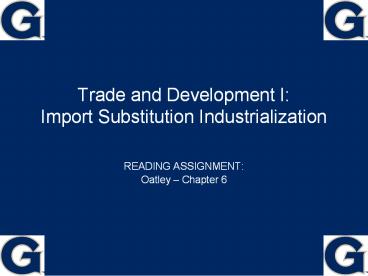Trade and Development I: Import Substitution Industrialization - PowerPoint PPT Presentation
1 / 30
Title:
Trade and Development I: Import Substitution Industrialization
Description:
Trade and Development I: Import Substitution Industrialization READING ASSIGNMENT: Oatley Chapter 6 * Plan Interests & Institutions explanation for ISI Economic ... – PowerPoint PPT presentation
Number of Views:498
Avg rating:3.0/5.0
Title: Trade and Development I: Import Substitution Industrialization
1
Trade and Development I Import Substitution
Industrialization
- READING ASSIGNMENT
- Oatley Chapter 6
2
Plan
- Interests Institutions explanation for ISI
- Economic justification for ISI
- What is ISI?
- The effect
3
Part 1 Interests Institutions explanation for
ISI
4
- Up through WWI, developing countries had liberal
trade policies - By late 1950s, developing countries turn
protectionist - 2 questions
- Who were the winners from globalization?
- Did they have political power?
- Trade politics in developing countries dominated
by urban-rural cleavage
5
- Generally, developing countries are abundantly
endowed with land and poorly endowed with
capital - Agriculture is the ________-________ sector
- EXPORT ORIENTED SECTOR
- Manufacturing is the ________-________ sector
- IMPORT-COMPETING SECTOR
- So, land-owners should be ___-free-trade
- PRO-
- Owners of capital should be ___-free-trade
- ANTI-
6
Recall Rogowskis model
7
Pro-trade ?
Pro-trade ?
URBAN-RURAL CONFLICT
CLASS CONFLICT
Examples Peron in Argentina, Vargas in Brazil
Anti-trade ?
Anti-trade ?
Pro-trade ?
Pro-trade ?
URBAN-RURAL CONFLICT
CLASS CONFLICT
Developing
Anti-trade ?
Anti-trade ?
8
Smoot-Hawley, Great Depression
Developing
9
Part 2 Intellectual justification for ISI
10
Intellectual justificationStructuralist argument
- The shift of resources from agriculture to
manufacturing would not occur unless the state
adopted appropriate industrial policy
11
International Anti-trade stance
- Haberler Report
- Von Haberler Harvard economist (Austrian
origin) - Reports a decline in the terms of trade for
primary producers - From 1955 commodity prices fell by 5,
industrial prices rose by 6 - 1964 United Nations Conference on Trade and
Development (UNCTAD) ? Group of 77 - (Von Haberler did not mean that there was a
systematic long-term (secular) decline in the
terms of trade. He left Harvard in 1971 for
American Enterprise Institute) - ? SingerPrebisch Theory (Intellectual
justification for ISI) - Participation in GATT will make it harder for
developing countries to industrialize
12
Terms of trade
- Relates the price of a countrys exports to the
price of its imports - Improvement in the terms of trade
- Price of exports is rising relative to the price
of imports - Decline in the terms of trade
- Price of exports is declining relative to the
price of imports
13
(No Transcript)
14
Summarizing Why did governments adopt ISI?
- Interests
- Losers from globalization gain power during the
Great Depression - (Globalization dries up, so the winners lose
substantial income) - Ideas
- Some economists (legitimized by the United
Nations) argued against free trade
15
Part 3 What is ISI?
16
Import Substitution Industrialization
- Industrialize by substituting domestically
produced goods for manufactured items previously
imported - Typically called ISI
- 2 stages
- Easy ISI
- Secondary ISI
17
Easy ISI
- Develop domestic manufacturing of simple consumer
goods - Soda, beer, apparel, shoes, furniture
- What do you mean by easy? Easy how? How is it
easy? - Large domestic demand preexisting
- Requires Low-Tech machines
- Requires low-skilled labor
- Ya know easy.
18
Asia Latin America
- Both practiced easy ISI
- But then Asian countries switched to an
EXPORT-ORIENTED STRATEGY - Producing manufactured goods that can be sold in
international markets - EXPORT rather than produce exclusively for the
domestic market - Latin America moved to SECONDARY ISI
19
SECONDARY ISI
- Production of consumer durable goods,
intermediate inputs, and the capital goods needed
to produce consumer durables - E.g., automobiles (Argentina, Brazil, Chile)
- Begin by importing auto pieces and assembling
them domestically - Gradually, increase the of locally produced
parts
20
(No Transcript)
21
Argentine Torino http//www.taringa.net/posts/auto
s-motos/4559857/Autos-del-Turismo-Carretera-Chevy-
Falcon-Dodge-Torino.html http//www.taringa.net/p
osts/autos-motos/16261340/Renault-Torino-un-fierra
zo-D.html
22
Government policies to promote ISI
- Investment in activities the private sector would
not produce - Roads, transportation networks, electricity,
telecommunications - Large-scale operations steel plants, auto
plants - State-owned Enterprises ( mixed-owned)
- Chemical, telecommunications, electricity,
railways, metal fabrication - Trade barriers (tariffs)
- Tax policies
- Taxed agricultural exports through Marketing
Boards - Marketing Board purchased crops from farmers at
below-world market prices, then sell them on the
world market at world market prices
23
- Marketing boards
- Disincentivized agricultural production
- Subsidized industrialization
- Tariffs
- Incentivized local consumers to buy locally
manufactured industrial products
24
Closer look _at_ Brazil
- Labor-abundant, capital scarce
- Late 19th century slave labor
- 1877-78 Grande Seca (Great Drought) in the
cotton-growing northeast, led to major turmoil,
starvation, poverty and internal migration - Slavery abolished 1884
- Still, primary commodities 1 Coffee
dominate until the Great Depression - Drop in prices hurt land owners again this time
a coup - 1930 Getulio Vargas
- Pursues the easy ISI stage Protectionism
promotes light manufacturing - Transition to 2ndary ISI in 1950s
25
Oatley 2011 pages pg. 126-127
26
http//www.youtube.com/watch?vcbOdUqf-mUI
27
Argentinas Bicentennial Celebration
http//www.boston.com/bigpicture/2010/05/argentin
as_bicentennial.html
28
Results
- How did they pay for industrialization?
- Borrowed
- How did they pay it back?
- Latin American Debt Crisis (1982)
- The Lost Decade
- IMF to the rescue?
- Washington Consensus
- Dismantle the states presence in the economy
29
Take-homes
- Political motivation for ISI
- Losers from trade in Latin America (urban sector)
gain political power - Intellectual justification for ISI
- Declining terms of trade for primary products
- Asia LA both practice easy ISI
- LA moves to Secondary ISI
30
Thank youWE ARE GLOBAL GEORGETOWN!

